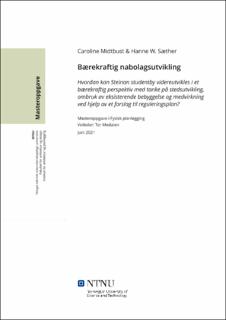| dc.description.abstract | I lys av klimautfordringer, befolkningsvekst og utvikling av kompakte byer blir dagens byutvikling utfordret av fortetting rundt knutepunkt, tilrettelegging av miljøvennlig mobilitet og nedbygging av jordbruksarealer. Dette medfører at flere bor tettere og på et mindre areal.
I dag fremsettes de nye reguleringsplanene som oftest av private aktører alene eller på vegne av kommunen. Likevel er det utfordrende at Trondheim kommune har mange eldre reguleringsplaner som ikke er i tråd med dagens bærekraftige byutvikling, noe som gjør at det ofte blir søkt om dispensasjoner fra disse.
For å kunne undersøke hvorvidt de tre bærekraftdimensjonene implementeres i nye reguleringsplaner, tar oppgaven utgangspunkt i problemstillingen «Hvordan kan Steinan studentby videreutvikles i et bærekraftig perspektiv med tanke på stedsutvikling, ombruk av eksisterende bebyggelse og medvirkning ved hjelp av et forslag til reguleringsplan?». Oppgaven søker å finne svar på hvilke tiltak som er viktige i en reguleringsplan for å sikre en mer bærekraftig byutvikling.
Oppgaven sammenfatter resultater fra tidligere teori og empiri med intervju, stedsanalyse og analyser av casestudiet, samt befaring fra området. Funnene viser at den nye reguleringsplanen for Steinan studentby utarbeidet av TAG Arkitekter på vegne av Bolig Norge og Fredensborg Bolig, har et gjennomgående fokus på de tre bærekraftdimensjonene. Likevel viser funnene at den sosiale bærekraften kunne vært bedre ivaretatt i planforslaget. Oppgaven vil undersøke viktigheten av sosial bærekraft i et byutviklingsperspektiv i lys av den kompakte byen og miljømessig og økonomisk bærekraft.
For å sikre en mer sosial bærekraft må det legges til rette for å skape likhet og inkludering. Ved å tilrettelegge for et mangfold av boligtypologier med en variasjon i størrelse, sosiale møteplasser og felles aktiviteter kan dette tilrettelegge for utvikling av et område med hensyn på sosialisering, inkludering og normalisering blant beboere. | |
| dc.description.abstract | Considering climate challenges, population growth and the development of compact cities, current urban development is being challenged by densification around hubs, the facilitation of environmentally friendly mobility and the reduction of agricultural land. This leads to more people live closer together and in a smaller area.
Today, the new zoning plans are most often presented by private actors alone, or on behalf of the municipality. Nevertheless, it is challenging that Trondheim municipality has many older zoning plans that are not in line with current sustainable urban development, which means that exemptions from these are often applied for.
To investigate whether the three dimensions of sustainability are implemented in current zoning plans, this master´s thesis tries to find answers to this. Through the problem “How can Steinan studentby be further developed in a sustainable perspective with regard to site development, reuse of existing buildings and participation by using a proposal for a zoning plan?", seeks the task of finding answers to what measures can be implemented in a regulatory process to ensure a more sustainable urban development.
The master´s thesis summarizes results from previous theory and empirical data with interviews, site analysis and analyzes of the case study, as well as inspections from the area. The results show that the new zoning plan for Steinan studentby by TAG Architects on behalf of Bolig Norge and Fredensborg Bolig, has a general focus on the three sustainability dimensions. Nevertheless, the results show that social sustainability could have been better taken care of in the planning process. Social sustainability in an urban development perspective is often overlooked considering the compact city and environmental and economic sustainability.
To ensure more social sustainability, efforts must be made to create equality and inclusion. By facilitating a diversity of housing typologies with a variation in size, social meeting places and common activities, this will facilitate the development of an area in terms of socialization, including and normalization among residents. | |
